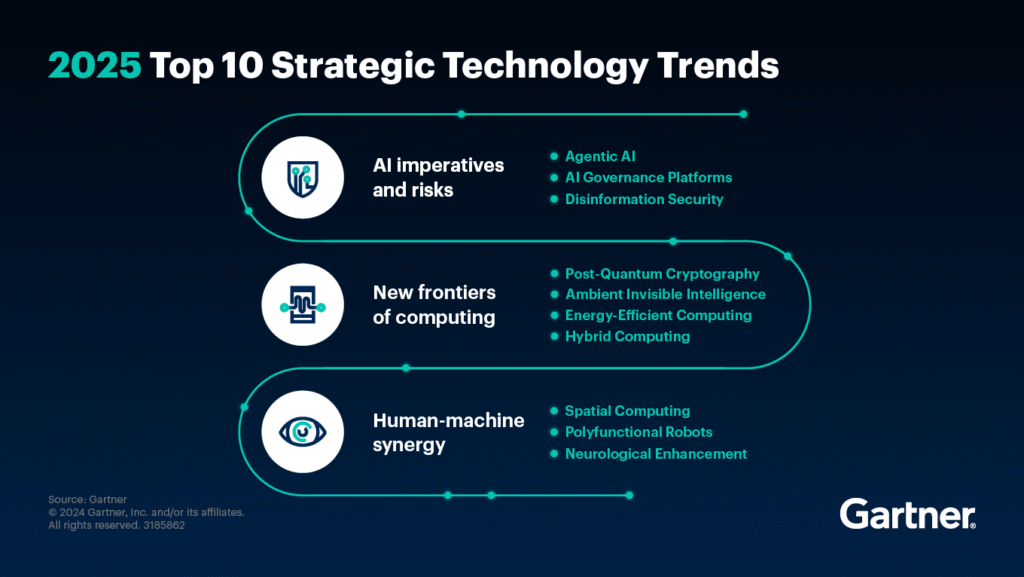
Digital Technologies
Technology is terrific; it can bless us and be used as a tool to preach the Gospel or help us grow in our faith. But it is a tool and should not replace the purpose of the One it was created for. Addressing the challenge of excessive AI advancement calls for wisdom derived from the Word (the Bible), harmoniously combined with innocence.
Digital Technologies are incredible Burning Bushes. We must ensure we approach the Author of intelligence and the Source of meaning, purpose, and truth. Digital Technology is making huge strides. However, there are enormous challenges. Organizations remain siloed, automation is hard, and often best practices are ignored. Digital Technology is making huge strides.
Here are the top 10 Technology Trends According to Gartner

AI Imperatives and Risks
- Agentic AI: Intelligent software entities that can complete tasks and achieve goals autonomously. By 2028, Gartner predicts 15% of day-to-day work decisions will be made through agentic AI, up from 0% in 2024. Gartner: Top 10 strategic technology trends for 2025 conventional asymmetric cryptography | Network World
- AI Governance Platforms: Systems that manage and control AI by ensuring ethical, responsible, transparent, fair, and safe usage, establishing alignment across AI usage, organizational values, and broader societal goals. Gartner’s top 10 strategic technology trends for 2025 – Devolutions Blog
- Disinformation Security: Solutions that utilize media forensics and natural language processing to detect and counteract false information, crucial as studies show 66% of U.S. consumers perceive over three-quarters of social media news as biased. Gartner’s Top 10 Tech Trends Of 2025: Agentic AI and Beyond
New Frontiers of Computing
- Post-Quantum Cryptography (PQC): Gartner predicts that by 2029, advances in quantum computing will make conventional asymmetric cryptography unsafe to use, highlighting the significance of quantum-resistant data protection methods. Gartner: Top 10 strategic technology trends for 2025conventional asymmetric cryptography | Network World
- Ambient Invisible Intelligence: Small, inexpensive sensors and tags that track the location and status of various objects or environments and send data in real time, becoming a key source for AI and analytics. Top 10 Strategic Technology Trends 2025 according to Gartner – Exorigo – Upos
- Energy-Efficient Computing: Building and operating computers, data centers, and digital systems in ways that achieve necessary performance standards while reducing energy consumption and minimizing carbon footprint. Gartner’s top 10 strategic technology trends for 2025 – Devolutions Blog
- Hybrid Computing: Systems that combine different technologies such as CPUs, GPUs, edge devices, neuromorphic, and quantum capabilities, allowing organizations to leverage the strengths of each to solve complex problems. Gartner Top 10 Technology Trends for 2025
Human-Machine Synergy
- Spatial Computing: Technology that places digital content in real space, allowing consumers to interact with that content in an immersive and realistic way through augmented reality, mixed reality, or other immersive technologies. Top 10 Strategic Technology Trends 2025 according to Gartner – Exorigo – Upos
- Polyfunctional Robots: Versatile robots that can perform multiple functions rather than being limited to a single task, expected to become part of everyday life with 80% of humans potentially engaging with them daily by 2030. Gartner: The Top 10 Strategic Technology Trends For 2025
- Neurological Enhancement: Technologies that improve cognitive abilities by reading and decoding brain activity and optionally writing to the brain, with 60% of IT workers predicted to use such technologies by 2030. Top 10 Strategic Technology Trends 2025 according to Gartner – Exorigo – Upos
Yes, Digital Technology is making huge strides. However, there are enormous challenges. Organizations remain siloed, automation is hard, and often best practices are ignored.
Culture is the key to your Digital Transformation success. Transformation starts with Culture.
It is interesting to note that many of the principles of Culture for Digital Transformation are in essence Biblical and Christian. Prime among those is Servant Leadership.
Several years ago, I delivered a TEDx presentation on organizational culture that remains just as applicable today as when it was first given.
Servant Leadership and Servant Leaders
In Philippians 2: 3-4 we read:
Don’t push your way to the front; don’t sweet-talk your way to the top. Put yourself aside, and help others get ahead. Don’t be obsessed with getting your own advantage. Forget yourselves long enough to lend a helping hand. The Message
Serving is praised as a virtue, yet it seems much more difficult to realize it in practice. Inspiration and goose bumps well up when stories are told of unselfish sacrifice and service for noble causes: in social service, in politics, in religion, and — why not even in the military. However, there is a flip side. Our culture sometimes places the wrong emphasis when it rewards greed, aggrandized egos, and cut-throat approaches in climbing the corporate ladder. In a flattened world, we cannot afford to reward selfish ambitions. The service culture sees the success of customer, shareholder, employee, and partner as essential requirements to fulfillment. It is service oriented. In a service oriented enterprise, greed is not good. 1 Success is a side effect, not the focus. Success is not just about finances; it is about how well others are served and elevated. A service oriented culture means our main function and purpose is found in serving others: helping them achieve their potential.
The prayer of St. Francis of Assisi is compelling:
O Divine Master, grant that I may not so much seek to be consoled as to console; to be understood, as to understand; to be loved, as to love; for it is in giving that we receive, it is in pardoning that we are pardoned, and it is in dying that we are born to eternal life.
If organizations develop a culture of service, everyone benefits. Is this new? Haven’t commercial organizations been promising and delivering services for centuries? Yes, the notion of service orientation is not new. In fact, most commercials emphasize this customer and service oriented attribute of the company that is promoting the product. Reality, though, is something else. It is one thing to express service orientation in brochures and commercials, but it is quite another to actually be a service oriented company.
Some trends and cultural changes, however, are coming together at an increasing pace to give birth to this new type of service oriented enterprise. The focus of this section is the attributes of service orientation as a corporate culture, or as a virtue, so to speak.
Enterprises are about people, not about finances or making the revenue forecasts at all cost. Doesn’t this contradict and go against everything we have learned in a “go and get them” culture? It does, and it will. Many times executives try to cut corners to make the
In fact our Lord Jesus Christ illustrated the ultimate Servant Leadership through washing the feet of His disciples. He is the ultimate example.
In my book Service Oriented Enterprises, I identified Servant Leadership as the cornerstone attribute for successful enterprise transformation.

The “Digital” Component: Technology as the Catalyst
The “Digital” dimension encompasses the vast ecosystem of emerging technologies that are fundamentally reshaping how we live, work, and interact. At the forefront of this technological revolution stands Artificial Intelligence, which has emerged as the most transformative force of our era. AI’s influence extends far beyond simple automation— it’s redefining decision-making processes, customer experiences, operational efficiency, and strategic planning across every industry vertical.
Beyond AI, the digital landscape includes:
- Cloud computing enabling scalable, flexible infrastructure
- Internet of Things (IoT) creating interconnected, intelligent environments
- Blockchain revolutionizing trust and transparency
- Advanced analytics and big data turning information into actionable insights
- Robotic Process Automation (RPA) streamlining repetitive tasks
- Edge computing bringing processing power closer to data sources
- 5G and connectivity enabling real-time, ubiquitous communication
These technologies don’t operate in isolation — they form an integrated ecosystem where each amplifies the capabilities of others, creating exponential rather than incremental improvements.
The “Transformation” Component: Culture and Human-Centered Change
The “Transformation” element addresses the often-overlooked human dimension of digital change. This encompasses the cultural evolution, organizational restructuring, and process optimization necessary to harness technology’s full potential. Without this component, even the most advanced technologies fail to deliver promised results.
Cultural Transformation involves:
- Mindset shifts from traditional to digital-first thinking
- Leadership evolution toward data-driven, agile decision-making
- Employee empowerment through digital skills development and continuous learning
- Collaborative ecosystems that break down organizational silos
- Innovation culture that embraces experimentation and calculated risk-taking
- Customer-centricity placing user experience at the heart of all decisions
Best Practices Implementation includes:
- Change management strategies that guide people through transformation
- Agile methodologies enabling rapid adaptation and iteration
- Data governance frameworks ensuring quality, security, and compliance
- Process reengineering optimizing workflows for digital efficiency
- Skills development programs preparing workforce for future demands
- Performance measurement systems tracking transformation progress
The Synergy: Where Technology Meets Transformation
The true power of Digital Transformation emerges at the intersection of these two components. Technology provides the capabilities, while transformation ensures those capabilities are effectively adopted, utilized, and continuously optimized. Organizations that excel in both dimensions create sustainable competitive advantages, while those that focus on only one component often struggle with implementation challenges or fail to realize expected returns on investment.
This holistic approach recognizes that successful Digital Transformation is not merely about deploying new technologies — it’s about fundamentally reimagining how organizations create value, serve customers, and adapt to an increasingly dynamic business environment. The “Digital” provides the tools; the “Transformation” determines whether those tools become catalysts for growth or expensive technological experiments.
In 2021 I wrote a book titled How to Alleviate Digital Transformation Debt that addresses the technological, cultural, and organizational transformation challenges that are more pressing and relevant today than ever before.
